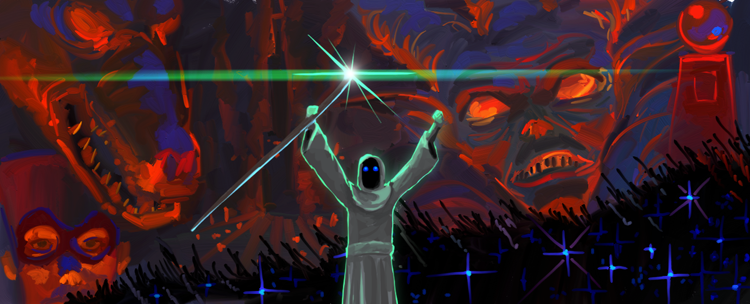Articles

LucasArts' Secret History #4: Loom The Turks and the Text
Alright, so now you've played Loom and you've read a couple of reviews, and you're probably thinking, Man, that crazy game! Would that I could understand its mysteries.
Or maybe that was just me. But either way, I refuse to let that desire burn up and float away like so much ash, whether it's for my benefit or for all of ours. Because like all acid-swilling pigs, I yearn for individuality – and Loom has achieved an individuality that is greater than any amount of tattoos or piercings. And the reason for that, as it so often is, is not that Loom was doing anything especially new or original, but that it was doing something very old – a once-hip thing that no-one remembers anymore.
Loom is a text-adventure.
"You fool!" I hear you cry. "Loom is a graphic adventure! Look at it! See the images!"
Well of course, you're correct. But the things that make a game are more complicated than that. Just because a game has graphics, does that make it a graphic adventure? How can such things be defined?
Let's look at LucasArts for a moment. A company full of wild young Turks with radical ideas; games where you don't rack up a score, and you can't die. People like Ron Gilbert, David Fox and Gary Winnick laid out a new schematic for the adventure game, and it was to be a design that allowed them to usurp Sierra as the reigning kings of the genre. They had seen what had gone before and unlike the rest of us, they saw a potential for something better. By the early nineties this potential had been truly realised.
But Brian Moriarty was not a part of this vanguard. He joined LucasArts in 1988, a time when the first writhing pups had already been birthed from this so-called SCUMM, but he realised quickly that it was just an engine and not necessarily a philosophy. Indeed, Loom was the first game to be made in SCUMM concurrently with another (The Last Crusade), an action that forever extricated that code from the individual game and freed it for wider interpretation.
Because, you see, Moriarty was an Infocom boy. To this day he still describes his time there as "the best work experience I have ever had... My co-workers were frighteningly intelligent, well-read, articulate and witty." And what Infocom produced – the erstwhile text adventure – was referred to by its coders as 'interactive fiction.'
So when Moriarty arrived in Marin County, he did not want to tear the world in half and start again. He wanted to continue the battle he had begun to fight with Beyond Zork in 1987 – the integration of the text adventure into the graphical age.
As an English major, I could imagine a whole new form of interactive literature; and as a programmer, the potential for improving the technology was obvious.
This, coincidentally, is a similar struggle to the one LucasArts faced with their 2D games and the advent of graphics cards and true 3D a few years later. But that is another story...
So let's look at Loom. It has no inventory; it has no verb icons. It has no text parser. It is a stripped down adventure game if ever there was one – the literal definition of 'point-and-click.' The protagonist, Bobbin Threadbare, has a magical distaff, and this is the sole bridge between you, the player, and him and his environment.
And – especially compared to the previous three LucasArts games – it's really rather easy, isn't it? Certainly possible to finish in a single sitting, the first time you play. Much like a book, I suppose.
Ho ho! You see what I did there? But this is really the key. Because Loom is not a subjective experience. It's extremely linear – especially when placed next to its cousin The Secret of Monkey Island. You do not pick things up and decide when and where to use them, nor do you decide what to say to the people you meet. All you do, in fact, is play magical drafts with your distaff and watch the story unfold around you.
"That doesn't make it a text adventure!" you bellow at me.
Well, I suppose not. But it has the spirit of a text adventure. That was what Moriarty knew, and it is what he created. It's just that at LucasArts, there was lots and lots of money. Full-screen graphics weren't out of the question. A CD-soundtrack was entirely possible. Hell, he could even write some kind of introductory radio-style play if he felt like it. Such out-of-game exposition was a welcome and useful aspect of the text-adventure era.
So Loom is basically a souped-up text adventure. A piece of interactive fiction more than it is a game. That is why it is easier than other LucasArts games, and that is why it is so different to the rest of them. It features pretty pictures in lieu of a page of words, and it disguises the code-based puzzle system by taking advantage of new-fangled sound technology.
It's a throwback. Like me, I suppose. Which might be why I like it so much.